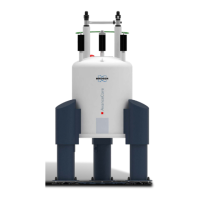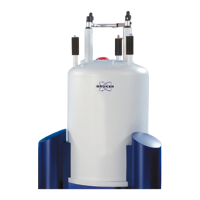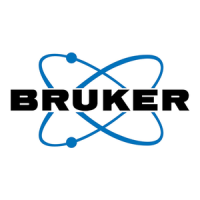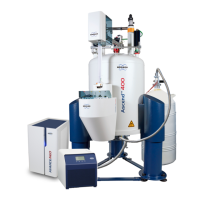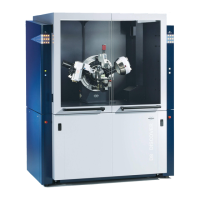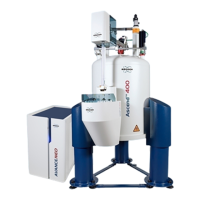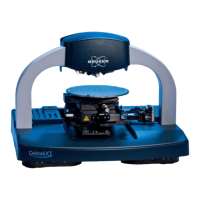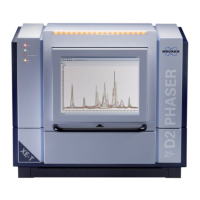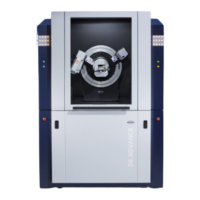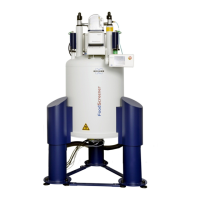Do you have a question about the Bruker Ascend 400'54 and is the answer not in the manual?
Details for Bruker BioSpin AG, including address, phone, fax, and email.
Provides essential info on handling the magnet system and its components.
Outlines manufacturer's liability, support, warranty terms, and publication rights.
Illustrates and describes the main components of the NMR magnet system.
Defines qualifications for personnel operating or servicing the magnet system.
Details the customer's duties to ensure safe operation and maintenance of the system.
Explains the meaning of DANGER, WARNING, CAUTION, and NOTICE indicators.
Addresses risks associated with personnel and the system's intended application.
Highlights risks related to safety devices and the use of approved spare parts.
Covers risks from unreadable signs, labels, and exposure to magnetic fields.
Details hazards associated with cryogenic agents and electrical components.
Addresses risks during a magnet quench and from pressurized gases within the system.
Covers hazards from low temperatures and spontaneous ignition/explosion risks.
Details risks associated with system tilting and handling heavy components.
Provides precautions for safe transport, covering packing and handling.
Specifies required PPE for safe operation, including goggles, gloves, clothes, and shoes.
Illustrates and describes the cryostat's safety devices like quench valves and drop-off plates.
Outlines actions during emergencies and requirements for fire department notification.
Covers safety guidelines for transporting the system and details on its original packaging.
Details how to inspect deliveries for damage and procedures for box disposal.
Provides instructions for transportation using forklifts, pallet jacks, and cranes.
Guidelines for storing the cryostat before installation and information on final disposal.
Specifies that only approved personnel should perform assembly procedures.
Lists critical safety warnings for operating the magnet system.
Describes how to start and stop the magnet stand using the pneumatic controller.
Highlights safety precautions and required qualifications for troubleshooting tasks.
Covers common problems encountered during transportation and assembly, with solutions.
Addresses problems related to the cooling process, including liquid nitrogen transfer and vacuum levels.
Details problems during magnet energizing, shimming, standard operation, and de-energizing.
Provides steps to follow after a magnet quench event, including safety checks and refills.
Lists safety warnings and required PPE for performing maintenance tasks on the system.
Describes cleaning procedures and provides a timetable for routine maintenance checks.
States that disassembly must only be performed by authorized Bruker Service personnel.
Lists and categorizes various warning signs used in the manual and on the equipment.
Lists all figures and tables included in the appendix for easy reference.
Defines key terms and acronyms used throughout the manual for clarity.
Provides detailed specifications and environmental conditions for the cryostat and magnet system.
Details for Bruker BioSpin AG, including address, phone, fax, and email.
Provides essential info on handling the magnet system and its components.
Outlines manufacturer's liability, support, warranty terms, and publication rights.
Illustrates and describes the main components of the NMR magnet system.
Defines qualifications for personnel operating or servicing the magnet system.
Details the customer's duties to ensure safe operation and maintenance of the system.
Explains the meaning of DANGER, WARNING, CAUTION, and NOTICE indicators.
Addresses risks associated with personnel and the system's intended application.
Highlights risks related to safety devices and the use of approved spare parts.
Covers risks from unreadable signs, labels, and exposure to magnetic fields.
Details hazards associated with cryogenic agents and electrical components.
Addresses risks during a magnet quench and from pressurized gases within the system.
Covers hazards from low temperatures and spontaneous ignition/explosion risks.
Details risks associated with system tilting and handling heavy components.
Provides precautions for safe transport, covering packing and handling.
Specifies required PPE for safe operation, including goggles, gloves, clothes, and shoes.
Illustrates and describes the cryostat's safety devices like quench valves and drop-off plates.
Outlines actions during emergencies and requirements for fire department notification.
Covers safety guidelines for transporting the system and details on its original packaging.
Details how to inspect deliveries for damage and procedures for box disposal.
Provides instructions for transportation using forklifts, pallet jacks, and cranes.
Guidelines for storing the cryostat before installation and information on final disposal.
Specifies that only approved personnel should perform assembly procedures.
Lists critical safety warnings for operating the magnet system.
Describes how to start and stop the magnet stand using the pneumatic controller.
Highlights safety precautions and required qualifications for troubleshooting tasks.
Covers common problems encountered during transportation and assembly, with solutions.
Addresses problems related to the cooling process, including liquid nitrogen transfer and vacuum levels.
Details problems during magnet energizing, shimming, standard operation, and de-energizing.
Provides steps to follow after a magnet quench event, including safety checks and refills.
Lists safety warnings and required PPE for performing maintenance tasks on the system.
Describes cleaning procedures and provides a timetable for routine maintenance checks.
States that disassembly must only be performed by authorized Bruker Service personnel.
Lists and categorizes various warning signs used in the manual and on the equipment.
Lists all figures and tables included in the appendix for easy reference.
Defines key terms and acronyms used throughout the manual for clarity.
Provides detailed specifications and environmental conditions for the cryostat and magnet system.
| Magnet Type | Superconducting |
|---|---|
| Magnetic Field Strength | 9.4 Tesla |
| Frequency | 400 MHz |
| Temperature Range | -150°C to +150°C |
| Magnet Bore | 54 mm |
| Console | Avance Neo |
| Software | TopSpin |
| Nucleus | 1H, 13C, 15N, 31P |
| Sample Type | Liquids, solids |
| Probe Type | broadband |
| Sample Diameter | 5 mm |
